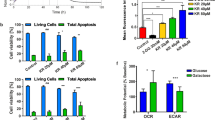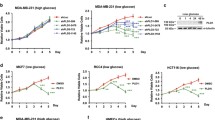Abstact
In order to conduct a physiological functional study of lactate dehydrogenase (LDH) and glycerol-3-phosphate dehydrogenase (GPDH), we engineered a CHO dhfr − cell, by overexpressing either the anti-sense LDH-A RNA (anti-LDH cells) or GPDH (GP3 cells), or both (GP3/anti-LDH cells). LDH activity in the cell cytosol, and lactate content and pHe change in the growth media were found to decrease according to the order: cell lines GP3/anti-LDH − anti−LDH − GP3 − CHO. Intracellular ATP contents, representing the extent of respiration rate, also decreased, according to a rank order as follows: GP3 − CHO − GP3/anti−LDH − anti−LDH. We also attempted to identify and characterize any physiological changes occurring in the cells which harbored diverse metabolic pathways. First, anti-LDH cells with heightened respiration rates were found to display a higher degree of sensitivity to the prooxidant tert-butyl hydroperoxide (tBOOH), and the mitochondrial complex III inhibitor, antimycin A, than the GPDH-expressing cells (GP3 and GP3/anti-LDH), which have a lower respiration rate. Second, the anti-sense LDH-A RNA-expressing cells (anti-LDH and GP3/anti-LDH) evidenced a higher degree of resistance to apoptosis by cell-cell contact inhibition, and a faster doubling time (∼19 h compared with ∼26 h) than the CHO and GP3 cells. Additionally, cell growth in an extended culture under HCO3 −-free conditions to induce a steep acidification could be maintained with the anti-sense LDH-A RNA-expressing cells, but could not be maintained with the CHO and GP3 cells. Third, we observed that the most appropriate cell line for the optical production of a certain therapeutic protein (Tissue-Plasminogen Activator) was the GP3/anti-LDH cells. Collectively, our data indicate a variety of physiological roles for LDH and GPDH, including cellular acidosis, oxidoresistance, apoptosis by both acidosis and cell-cell contact inhibition, cell growth, and the generation of recombinant proteins.
Similar content being viewed by others
References
Van Hall G: Lactate as a fuel for mitochondrial respiration. Acta Physiol Scand 168: 643–656, 2000
Hood VL, Tannen RL: Protection of acid-base balance by pH regulation of acid production. N Engl J Med 339: 819–826, 1998
Bohnsack BL, Hirschi KK: Nutrient regulation of cell cycle progression. Annu Rev Nutr 24: 433–453, 2004
Yechoor VK, Patti ME, Saccone R, Kahn CR: Coordinated patterns of gene expression for substrate and energy metabolism in skeletal muscle of diabetic mice. Proc Natl Acad Sci U S A 99: 10587–10592, 2002
Gatenby RA, Gillies RJ: Why do cancers have high aerobic glycolysis? Nat Rev Cancer 4: 891–899, 2004
Dang CV, Semenza GL: Oncogenic alterations of metabolism. Trends Biochem Sci 24: 68–72, 1999
Palacino JJ, Sagi D, Goldberg MS, Krauss S, Motz C, Wacker M, Klose J, Shen J: Mitochondrial dysfunction and oxidative damage in parkin-deficient mice. J Biol Chem 279: 18614–18622, 2004
Lin SJ, Guarente L: Nicotinamide adenine dinucleotide, a metabolic regulator of transcription, longevity and disease. Curr Opin Cell Biol 15: 241–246, 2003
Winiarska K, Drozak J, Wegrzynowicz M, Jagielski AK, Bryla J: Relationship between gluconeogenesis and glutathione redox state in rabbit kidney-cortex tubules. Metabolism 52: 739–746, 2003
Wahlberg G, Adamson U, Svensson J: Pyridine nucleotides in glucose metabolism and diabetes: a review. Diabetes Metab Res Rev 16: 33–42, 2000
Fraisse L, Rey E, Rigoulet M: The organo-specific external NADH dehydrogenase of mammal heart mitochondria has an artefactual origin. Biochim Biophys Acta 1143: 190–198, 1993
Brunner NA, Brinkmann H, Siebers B, Hensel R: NAD+-dependent glyceraldehyde-3-phosphate dehydrogenase from Thermoproteus tenax. The first identified archaeal member of the aldehyde dehydrogenase superfamily is a glycolytic enzyme with unusual regulatory properties. J Biol Chem 273: 6149–6156, 1998
Randall DD, Rubin PM, Fenko M: Plant pyruvate dehydrogenase complex purification, characterization and regulation by metabolites and phosphorylation. Biochim Biophys Acta 485: 336–349, 1977
Tissenbaum HA, Guarente L: Increased dosage of a sir-2 gene extends lifespan in Caenorhabditis elegans. Nature 410: 227–230, 2001
Yamaza H, Chiba T, Higami Y, Shimokawa I: Lifespan extension by caloric restriction: an aspect of energy metabolism. Microsc Res Tech 59: 325–330, 2002
Baumgart E, Fahimi HD, Stich A, Volkl A: L-lactate dehydrogenase A4- and A3B isoforms are bona fide peroxisomal enzymes in rat liver. Evidence for involvement in intraperoxisomal NADH reoxidation. J Biol Chem 271: 3846–3855, 1996
Juel C: Lactate/proton co-transport in skeletal muscle: regulation and importance for pH homeostasis. Acta Physiol Scand 156: 369–374, 1996
Jeong DW, Kim TS, Cho IT, Kim IY: Modification of glycolysis affects cell sensitivity to apoptosis induced by oxidative stress and mediated by mitochondria. Biochem Biophys Res Commun 313: 984–991, 2004
Hwang K, Jeong DW, Lee JW, Kim IH, Chang HI, Kim HJ, Kim IY: Alteration of the NAD+/NADH ratio in CHO cells by stable transfection with human cytosolic glycerol-3-phosphate dehydrogenase: resistance to oxidative stress. Mol Cells 9: 429–435, 1999
Jeong D, Kim TS, Lee JW, Kim KT, Kim HJ, Kim IH, Kim IY: Blocking of acidosis-mediated apoptosis by a reduction of lactate dehydrogenase activity through antisense mRNA expression. Biochem Biophys Res Commun 289: 1141–1149, 2001
Christodoulides M, Boucher DW: The potency of tissue-type plasminogen activator (TPA) determined with chromogen and clot-lysis assays. Biologicals 18: 103–111, 1990
Castro MJ, Kingston IB, Anderson S: A spectrophotometric assay for the determination of the catalytic efficiency of plasminogen activators using a slowly hydrolyzed plasmin substrate. Anal Biochem 226: 225–231, 1995
Turrens JF, Freeman BA, Levitt JG, Crapo JD: The effect of hyperoxia on superoxide production by lung submitochondrial particles. Arch Biochem Biophys 217: 401–410, 1982
Turrens JF, Boveris A: Generation of superoxide anion by the NADH dehydrogenase of bovine heart mitochondria. Biochem J 191: 421–427, 1980
Wallace DC, Melov S: Radicals r'aging. Nat Genet 19: 105–106, 1998
Chen K, Liu Q, Xie L, Sharp PA, Wang DI: Engineering of a mammalian cell line for reduction of lactate formation and high monoclonal antibody production. Biotechnol Bioeng 72: 55–61, 2001
Orford K, Orford CC, Byers SW: Exogenous expression of beta-catenin regulates contact inhibition, anchorage-independent growth, anoikis, and radiation-induced cell cycle arrest. J Cell Biol 146: 855–868, 1999
Mueller PP, Schlenke P, Nimtz M, Conradt HS, Hauser H: Recombinant glycoprotein product quality in proliferation-controlled BHK-21 cells. Biotechnol Bioeng 65: 529–536, 1999
Lao MS, Toth D: Effects of ammonium and lactate on growth and metabolism of a recombinant Chinese hamster ovary cell culture. Biotechnol Prog 13: 688–691, 1997
Choi YS, Lee DY, Kim IY, Kang S, Ahn K, Kim HJ, Jeong YH, Chun GT, Park JK, Kim IH: Ammonia removal using hepatoma cells in mammalian cell cultures. Biotechnol Prog 16: 760–768, 2000
van de Loo JW, Creemers JW, Bright NA, Young BD, Roebroek AJ, Van de Ven WJ: Biosynthesis, distinct post-translational modifications, and functional characterization of lymphoma proprotein convertase. J Biol Chem 272: 27116–27123, 1997
Zhang JX, Krell PJ, Phillips JP, Forsberg CW: Expression of a bacterial endo (1-4)-beta-glucanase gene in mammalian cells and post translational modification of the gene product. Biochim Biophys Acta 1357: 215–224, 1997
Ayoubi TA, Meulemans SM, Roebroek AJ, Van de Ven WJ: Production of recombinant proteins in Chinese hamster ovary cells overexpressing the subtilisin-like proprotein converting enzyme furin. Mol Biol Rep 23: 87–95, 1996
Rajala RV, Datla RS, Moyana TN, Kakkar R, Carlsen SA, Sharma RK: N-myristoyltransferase. Mol Cell Biochem 204: 135–155, 2000
Zhang H, Williams-Dalson W, Keshavarz-Moore E, Shamlou PA: Computational-fluid-dynamics (CFD) analysis of mixing and gas-liquid mass transfer in shake flasks. Biotechnol Appl Biochem 41: 1–8, 2005
Koike G, Van Vooren P, Shiozawa M, Galli J, Li LS, Glaser A, Balasubramanyam A, Brown LJ, Luthman H, Szpirer C, MacDonald MJ, Jacob HJ: Genetic mapping and chromosome localization of the rat mitochondrial glycerol-3-phosphate dehydrogenase gene, a candidate for non-insulin-dependent diabetes mellitus. Genetics 38: 96–99, 1996
Miyajima H, Takahashi Y, Kaneko E: Characterization of the glycolysis in the lactate dehydrogenase-A dificiency. Muscle Nerve 18: 874–878, 1995
Author information
Authors and Affiliations
Corresponding author
Rights and permissions
About this article
Cite this article
Jeong, Dw., Cho, I.T., Kim, T.S. et al. Effects of lactate dehydrogenase suppression and glycerol-3-phosphate dehydrogenase overexpression on cellular metabolism. Mol Cell Biochem 284, 1–8 (2006). https://doi.org/10.1007/s11010-005-9004-7
Received:
Accepted:
Published:
Issue Date:
DOI: https://doi.org/10.1007/s11010-005-9004-7




